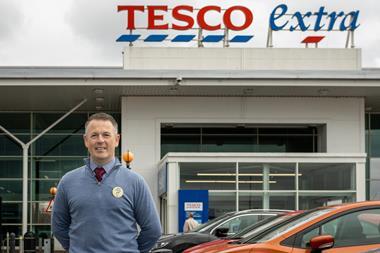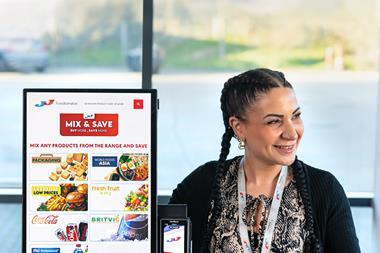Tim Hurrell is full of smiles. A diehard Hull City fan, this season is “a big adventure”. But it’s not as big as the venture he’s now running. After succeeding Guy McCracken as managing director of food retail at The Co-operative Group this July, he’s running a rejuvenated business of about 2,200 stores.
But assuming the society’s £1.57bn acquisition of Somerfield is rubber-stamped by the OFT later this year, he will preside over a food business with £8bn sales and, barring disposals, over 3,000 stores. Hurrell is relishing the opportunity.
“We are, in a way, a business under recovery,” he says, “but we have performed strongly in the past two to three years, with 11 quarters of consecutive growth.”
The Co-op’s results for the six months to 26 July confirm this. It has turned the corner since it posted a 3.1% fall in like-for-like sales in 2005. Latest figures show food sales rose 43.5% to £2.4bn, with like-for-like sales up 5% and trading profit up 67.7% to £126m.
But the headline numbers don’t tell the whole story. Strip out inflation and food sales are flat. The Somerfield acquisition becomes an essential ingredient in turning recovery to growth.
“This is the last real opportunity to create a fifth player that can really compete against the big four,” Hurrell says. “They have around a 75% share of the market – and that’s growing. The retailers in the shrinking part of the market are having to work hard to compete.”
Combining the operations of the Co-op and Somerfield will give it the clout it needs to compete with the multiples on price, he argues.
“There have been a lot of changes in the market on price, with the success of the discounters and the supermarkets’ 50p promotions,” he says. “We have to respond to this. The biggest benefit of the Somerfield acquisition is that we can improve our buying terms.”
While Hurrell believes the Co-op’s proposition – “a trusted brand and a major player in the c-store sector, owned by consumers and strong in ethics” – is still valid, adding pricing to the message saw it launch a new price-driven ad campaign last week called A Great Deal Locally. It doubled its usual press advertising activity to tell customers to leave cars at home and shop locally, highlighting better-than-half-price and bogof deals. It also plans to relaunch its value range Everyday in early 2009.
Hurrell admits the 50-line range has been neglected and will be significantly extended, bolstered by Somerfield’s well-established ‘Simply Value’ range. While Somerfield’s expertise in value will quicken the development, Hurrell insists the relaunch would happen regardless of the Somerfield deal. Hurrell is also working on simplifying price bands.
Last month The Grocer revealed two society-owned stores across the road from each other in Reigate, Surrey, were charging different prices for branded goods. It will operate on just four price bands based on format, while eliminating its price band for the 24 stores still operating under the Alldays fascia. Somerfield will also considerably boost the group’s distribution network.
“It has been cobbled together because of mergers with too many small depots,” Hurrell says. “Although we’ve got new distribution centres in Thurrock and Coventry and we’re opening one in the north next year, Somerfield will give us a good network and the volume we need.”
With Somerfield comes bigger stores too – a territory not usually associated with the Co-op. The average size of a Co-op store is 3,300 sq ft, against 7,200 sq ft for Somerfield. Last year the Co-op invested heavily in developing a large store proposition for sites of more than 15,000 sq ft. So far, Hurrell says the format has been a success, combining the group’s interests in travel, pharmacy and banking with its food offer.
Will the larger stores not be sold off? “It’s in the hands of the OFT,” he beams.
But assuming the society’s £1.57bn acquisition of Somerfield is rubber-stamped by the OFT later this year, he will preside over a food business with £8bn sales and, barring disposals, over 3,000 stores. Hurrell is relishing the opportunity.
“We are, in a way, a business under recovery,” he says, “but we have performed strongly in the past two to three years, with 11 quarters of consecutive growth.”
The Co-op’s results for the six months to 26 July confirm this. It has turned the corner since it posted a 3.1% fall in like-for-like sales in 2005. Latest figures show food sales rose 43.5% to £2.4bn, with like-for-like sales up 5% and trading profit up 67.7% to £126m.
But the headline numbers don’t tell the whole story. Strip out inflation and food sales are flat. The Somerfield acquisition becomes an essential ingredient in turning recovery to growth.
“This is the last real opportunity to create a fifth player that can really compete against the big four,” Hurrell says. “They have around a 75% share of the market – and that’s growing. The retailers in the shrinking part of the market are having to work hard to compete.”
Combining the operations of the Co-op and Somerfield will give it the clout it needs to compete with the multiples on price, he argues.
“There have been a lot of changes in the market on price, with the success of the discounters and the supermarkets’ 50p promotions,” he says. “We have to respond to this. The biggest benefit of the Somerfield acquisition is that we can improve our buying terms.”
While Hurrell believes the Co-op’s proposition – “a trusted brand and a major player in the c-store sector, owned by consumers and strong in ethics” – is still valid, adding pricing to the message saw it launch a new price-driven ad campaign last week called A Great Deal Locally. It doubled its usual press advertising activity to tell customers to leave cars at home and shop locally, highlighting better-than-half-price and bogof deals. It also plans to relaunch its value range Everyday in early 2009.
Hurrell admits the 50-line range has been neglected and will be significantly extended, bolstered by Somerfield’s well-established ‘Simply Value’ range. While Somerfield’s expertise in value will quicken the development, Hurrell insists the relaunch would happen regardless of the Somerfield deal. Hurrell is also working on simplifying price bands.
Last month The Grocer revealed two society-owned stores across the road from each other in Reigate, Surrey, were charging different prices for branded goods. It will operate on just four price bands based on format, while eliminating its price band for the 24 stores still operating under the Alldays fascia. Somerfield will also considerably boost the group’s distribution network.
“It has been cobbled together because of mergers with too many small depots,” Hurrell says. “Although we’ve got new distribution centres in Thurrock and Coventry and we’re opening one in the north next year, Somerfield will give us a good network and the volume we need.”
With Somerfield comes bigger stores too – a territory not usually associated with the Co-op. The average size of a Co-op store is 3,300 sq ft, against 7,200 sq ft for Somerfield. Last year the Co-op invested heavily in developing a large store proposition for sites of more than 15,000 sq ft. So far, Hurrell says the format has been a success, combining the group’s interests in travel, pharmacy and banking with its food offer.
Will the larger stores not be sold off? “It’s in the hands of the OFT,” he beams.


















No comments yet